![]()
![]()
![]()
Use LEFT and RIGHT arrow keys to navigate between flashcards;
Use UP and DOWN arrow keys to flip the card;
H to show hint;
A reads text to speech;
34 Cards in this Set
- Front
- Back
|
Displacement:
|
the change in position
|
|
|
position vector:
|

|
|
|
Average Velocity:
|

|
|
|
Instantaneous Velocity:
|

the limit of the average velocity as the time interval approaches zero, and it equals the instantaneous rate of change of position with time.
- magnitude of the vector at any instant is the speed of the particle at that instant - direction of the vector at any instant is the same as the direction in which the particle is moving at that instant. |
|
|
magnitude of instantaneous velocity:
|

the speed
|
|
|
What does acceleration describe?
|
how the velocity of the particle changes.
|
|
|
Average Acceleration:
|

during time interval as the velocity change divided by the time interval.
|
|
|
Instantaneous acceleration:
|

the limit of the average acceleration when point 2 approaches point 1 and the change in velocity and change in time approach zero.
|
|
|
The acceleration vector can be described:
|
- changes in the particle's speed
- its direction of motion |
|
|
Projectile:
|
any body that is given an initial velocity and then follows a path determined entirely by the effects of gravitational acceleration and air resistance.
|
|
|
trajectory:
|
the path followed by projectile.
|
|
|
key to analyzing projectile motion:
|
we can treat the x and y coordinates separately.
- x component of acceleration = 0 - y component of acceleration is constant = -g |
|
|
projectile diagram:
|
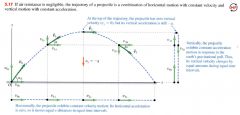
|
|
|
representing initial velocity by its magnitude and direction:
|

|
|
|
equations describing the position and velocity of the projectile at any time:
|
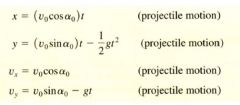
|
|
|
Projectile's speed at any time:
|

|
|
|
equation representing trajectory's shape in terms of x and y:
|

|
|
|
Problem solving strategy 3.1: Projectile Motion:
|
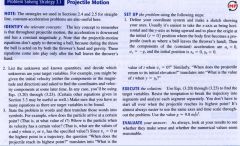
|
|
|
Problem solving strategy 3.1: Projectile Motion:
|
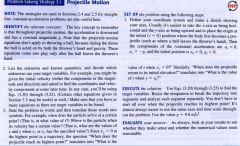
|
|
|
Motion in a circle:
|

|
|
|
Uniform Circular Motion:
|
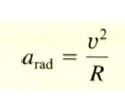
the motion of a particle moving in a circle with constant speed.
- acceleration vector is perpendicular (normal) to the path and therefore directed inward (never outward) toward the center of the circular path...... [ causes the direction of the velocity to change without changing the speed] |
|
|
acceleration and velocity for a particle in uniform circular motion and for a projectile with no air resistance.
|
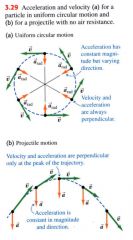
|
|
|
equation for the speed of a particle traveling around a circle:
|

|
|
|
another equation for uniform circular motion:
|

|
|
|
Centripetal acceleration:
|
the acceleration directed toward the center of the circle
|
|
|
period (T):
|
- another way to express magnitude of acceleration in uniform circular motion.
- the time for one revolution (one complete trip around the circle). |
|
|
Nonuniform circular motion:
|

|
|
|
Relative velocity:
|
the velocity seen by a particular observer... called the velocity relative to that observer
|
|
|
frame of reference:
|
a coordinate system plus a time scale.
|
|
|
In general, if A and B are any two points of frames of reference:
|

|
|
|
Problem Solving Strategy 3.2: Relative Velocity:
|
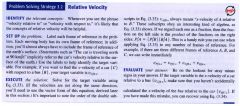
|
|
|
Galilean Velocity transformation:
|

relates the velocity of a body P with respect to frame A and its velocity with respect to frame B
|
|
|
Galilean Velocity transformation:
|

relates the velocity of a body P with respect to frame A and its velocity with respect to frame B
|
|
|
Summary:
|
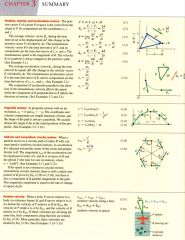
|

